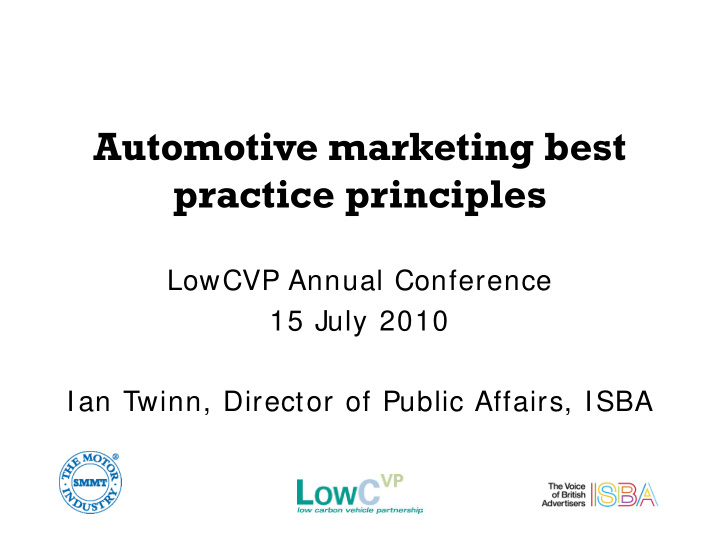



Automotive marketing best practice principles LowCVP Annual Conference 15 July 2010 Ian Twinn, Director of Public Affairs, ISBA
ISBA is the representative body for UK advertisers 400+ members from the biggest global advertisers, public sector and SMEs Accounting for over £10b ad spend in the UK Our mission is to help responsible advertisers be effective and help draw up the regulated space
Background to these best practice principles ISBA adds its support to car manufactures who through SMMT and ISBA membership have backed our collaboration with LowCVP LowCVP have been particularly tenacious is holding us all to the timetable The BBPs demonstrate the automotive industry’s commitment to transparent claims.
why do we need them? The key is in one of the criteria ...to •Enhance and support existing codes We are well regulated in the UK with strong co-regulation for marketing communications. But there are gaps in the wider marketing environment...having BBPs helps focus on delivering clear consumer information
How advertising is regulated The CAP and BCAP codes are owned by industry, and approved by OFT and Ofcom www.cap.org.uk The ASA – the independent adjudicator – is funded by advertisers via a levy
what do the codes cover? paid for advertising on TV and Radio – BCAP Then in the CAP code: Posters, press advertising, brochures, leaflets, circulars, mailings, e-mails, texts, fax, catalogues, cinema ads, ads on video on demand services, online pop ups and banners, paid for micro sites, sales promotions...with a planned extension to cover advertisers own websites (ie non paid for media)
Are there other rules? Yes ...from the EU the Unfair Commercial Practices Directive (UK CPRs) ...globally the ICC Advertising and marketing code, applied in many countries world wide...see the code at www.iccwbo.org
Using the guide Detailed rules apply to advertising, including direct mail and Advertorial content – so the BBP will not add very much and everyone should follow the codes and ASA rulings. However areas like press releases, Corporate reports, editorial in Corporate websites and point of sale and show window messages will benefit from applying the BBP They act like a framework filling in communication not already covered elsewhere
Environmental claims should: •Be specific •Not mislead •Be capable of substantiation •Be transparent and unambiguous •Follow a common sense approach Information should be clear and accessible: •Easy to locate on websites
Recommend
More recommend